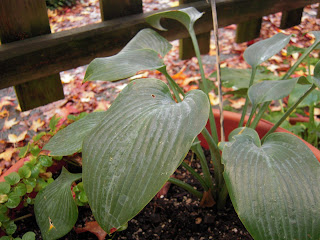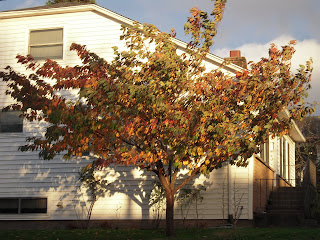Putting a Mid-Atlantic Garden to Bed
I have to admit that my extended Thanksgiving celebration created a lock on the lid of my laptop and prevented me from keeping up with reading and writing blogs. This holiday curse is bound to return every few months...and I'm okay with that! Yet somehow, amidst the rituals of Turkey dinner and days of delicious leftovers, I found some time to get outdoors and put my family's perennials to bed. This is not usually my job but to honor my goal of experiential learning, my Mother entrusted her beds to me and I went to work. The pictures below show the plants before and after being "put to bed"
Aster novi belgii (before and after)
Putting your garden to bed simply means doing all that you can to ensure the plants will survive the winter. The first step is to remove all dead and diseases debris. This includes dead leaves and annuals that need to be removed. Once the debris is removed, you are given a better sense of what shape your perennials are in and where cuts need to be made.
Peony
As the cold sets in, perennials focus their energy on their root systems so they can be cut back with out causing the plant too much stress. Before cutting back your perennials in the fall, determine which plants may be considered "winter interest" and hold off cutting those until the early spring (this category usually includes ornamental grasses and black eyed susans and whatever else is still green and still looks good around the first frost!).
Deciduous Fern
Mulch can be added to your perennial beds but its main purpose in a fall application is to maintain a consistent soil temperature and protect from extreme weather conditions. Therefore, in the mid-Atlantic region where I was working this week we didn't bother (and I probably wouldn't bother in the Pacific northwest region if I had my own perennials at home).
Coreopsis
In my Mom's garden I cut the aster and the coreopsis down to about two inches above the ground. I cut the peonies a little higher, mostly for aesthetic reasons. I gently pulled on the blades of the daylilies to grab all of the soggy and dead pieces and simply pulled out the dead flower stems from the center of the plants. The deciduous ferns were cut all the way to the ground because they were already rotting. Once I worked through the beds, I raked most of the leaves away from the plants to avoid smothering the cut stems and to avoid further slug-and-bug-attracting rot. I recommend using a small plastic rake for this job because a spring rake can easily get caught in the healthy plant and disturb the root system. The few hours of work I did made for a big improvement on the eyes. How well I did will be determined next spring (many thanks to my Mom for letting me experiment in her lovely garden!).
Daylilies
These beds were in good shape but the fall is a good time to year-end maintenance if it's needed. Perennials can be rearranged if you want a new look or a better suited spot or they can be divided (which just means splitting the large root system of a plant into two or more pieces and replanting the roots). Nutrients can be added in the fall as well. In annual or vegetable beds, all debris and roots will be removed (overwintering veggies excluded) so annual beds can be aerated and covered with nutrients and mulch before being put to rest. You can also plant a hearty cover crop that will protect the soil and add nutrients over the winter.
...and now on to the winter season...
























